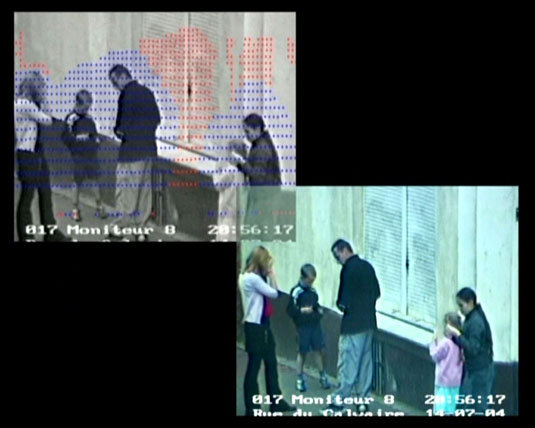Harun Farocki
dal 28/2/2009 al 17/4/2009
Segnalato da
28/2/2009
Harun Farocki
Galerie Barbara Weiss (old location), Berlin
The Berlin-based film-maker has produced over a hundred films and installations over the past 40 years: films that in their style and visual language - typical for his installations is the montage of 2 parallel images - do away with traditional genres and alternate between experiment, documentary and essay.

Galerie Barbara Weiss is delighted to present three film installations
by Harun Farocki in his first solo exhibition in Berlin.
The Berlin-based film-maker Harun Farocki (born 1944 in Novy Jicen,
Czechoslovakia) has produced over a hundred films and installations over
the past 40 years: films that in their style and visual language –
typical for Farocki’s installations is the montage of two parallel
images – do away with traditional genres and alternate between
experiment, documentary and essay.
Since producing the autobiographical video installation /Schnittstelle
(Interface)/ for a group exhibition at the Musée d’art Villeneuve d’Ascq
in Lille in 1995, Farocki – who is also active as an author, curator,
teacher and as a screenwriter for the Berlin director Christian Petzold
– has increasingly shown his work outside the cinema context in art
institutions. Important stages were documenta X and documenta 12, where
he showed /Stilleben (Still Life)/ in 1997 and /Deep Play/ in 2007. A
selection of his video installations will shortly go on view in
combination with work by Rodney Graham at Jeu de Paume in Paris. Tate
Modern is presenting a retrospective of Farocki’s work in the autumn
alongside an exhibition with many installations at Raven Row.
The video installations presented at Galerie Barbara Weiss –
/Gegen-Musik (Counter-Music)/, 2004, /Aufstellung (In-Formation),/ 2005
and /Zur Bauweise des Films bei Griffith (On Construction of Griffith’s
Films)/, 2006 – are different in character in both form and content:
/The city today is as rationalised and regulated as a production
process. The images which today determine the day of the city are
operative images, control image./ (H. Farocki)
In the two-channel projection /Gegen-Musik (Counter-Music)/, which was
produced and exhibited during Lille, European Capital of Culture 2004,
Harun Farocki makes use of material filmed in Lille and from CCTV
surveillance systems to reflect on how a day in the life of a city might
currently be depicted.
Here Farocki links to historical city films like Dziga Vertov’s /Der
Mann mit der Kamera (The Man with a Movie Camera)/ or Walther Ruttmann’s
/Berlin – Die Symphonie einer Großstadt (Berlin – Symphony of a Great
City) /(1927), from both of which he also quotes. While Ruttmann and
Vertov filmed as if they were on voyages of discovery, today’s
film-maker needs to draw on the huge depots filled with images from
surveillance cameras on public transport, sewage pipes and sleep labs.
Using these contemporary procedures of image production and urban
representation Farocki shows a city in a current cross section.
/The diagrams used to help to represent consumer shopping baskets, the
pensions deficit or migration are anachronistic. They hark back to
nineteenth-century political allegories/. (H. Farocki)
In /Aufstellung (In-Formation)/, created for the exhibition project
Migration at the Kölnischer Kunstverein in 2005, Farocki shows a collage
of statistics, pictograms, bar graphs and pie charts. They are all
historical and contemporary diagrams from newspapers, school text books
and official documents that provide a highly schematised account of
migration within the Federal Republic of Germany. Through his ingenious
editing of this material Farocki undertakes a conceptual critique that
demonstrates the “touching incapacity of abstraction” (Farocki). At the
same time he follows the iconic and symbolic figures back to their
origins and investigates them in terms of a subtext that would certainly
surprise those who designed them.
/This sequence is like one of animals who only exist in order to be an
example for the truth of Darwin’s theory. But cinema Darwinism is
neither true nor false./ (H. Farocki)
The two-channel video installation /Zur Bauweise des Films bei Griffith
(On Construction of Griffith’s Films),/ which was first shown at the
/forum expanded /section of the Berlin Film Festival in 2006, displays
shot/counter-shot sequences from D.W. Griffith’s silent film
/Intolerance/ (1916), among others, on two monitors – much like an
experimental setup. These sequences can be interpreted as an aesthetic
and political break with early cinema’s narrative tracking shots that
would lead to commercial cinema’s prised-open imagery, narrowed
perspective and instrumentalising gaze. Farocki exemplifies this
development through a juxtaposition of individual image sequences,
commented by intertitles, from /Intolerance/ and Griffith’s earlier film
/The Londale Operator /(1911).
The strategy of double projection as an extended montage technique
enables Harun Farocki to increase the relationality of the image per se.
The jumping back and forth that occurs here directs the attention of the
viewer, whose immediate task is one of correlation, in several
directions at once, addresses questions of simultaneity and disparity
and juxtaposes various narrative territories. In his presentation of two
images at the same time Farocki reflects on the conditions of production
underlying his own films. In 1995, in the film installation
/Schnittstelle/ (/Interface/), he had already asked if /viewing/ had to
have a purpose. He describes his own editing suite as a /enciphering/ or
/deciphering/ machine, keeping open the question as to whether mysteries
should be unravelled or preserved.
Barbara Buchmaier
On Saturday March 21, 2009 at 7pm, a conversation with Harun Farocki,
Diedrich Diederichsen and Bert Rebhandl will take place at the first
floor of Galerie Barbara Weiss.
Opening: Sunday, March 1, 2009, 11 am – 1 pm
Galerie Barbara Weiss
Zimmerstrasse 88-91 - Berlin
Opening hours Tuesday – Saturday, 11 am-6 pm
Free admission



